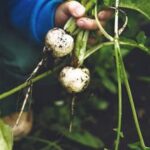Vegetable gardening in Oregon has become increasingly popular in recent years, as more and more people are embracing the satisfaction of growing their own food. The mild climate and fertile soil in Oregon make it an ideal location for cultivating a wide variety of vegetables. Whether you’re a seasoned gardener or a beginner, there are plenty of reasons to start your own vegetable garden in this beautiful state.
The diverse climate in Oregon offers gardeners the opportunity to grow a wide range of vegetables throughout the year. From cool-weather crops in the spring to heat-loving vegetables in the summer, there is no shortage of options for gardeners in Oregon. With the rising interest in organic and sustainable living, many Oregonians are turning to vegetable gardening as a way to connect with nature and reduce their environmental impact.
In this article, we’ll explore the best vegetables to grow in Oregon’s climate, as well as provide tips for starting and maintaining a successful vegetable garden. We’ll also discuss important factors such as soil preparation, dealing with pests and diseases, watering and irrigation techniques, harvesting and storing your homegrown produce, and resources available to support vegetable gardeners in Oregon.
Whether you have limited space or ample room for gardening, there’s something for everyone looking to delve into the world of vegetable gardening in Oregon.
Best Vegetables to Grow in Oregon’s Climate
Oregon’s mild and temperate climate makes it an ideal location for vegetable gardening. With its long growing season and abundant rainfall, Oregon provides the perfect environment for a wide variety of vegetables to thrive. Whether you’re a seasoned gardener or just starting out, there are plenty of options to choose from when deciding what to plant in your Oregon garden.
One of the best vegetables to grow in Oregon’s climate is kale. Known for its hardiness and ability to withstand cold temperatures, kale is a staple in many Oregon gardens. It can be harvested throughout the year and is packed with nutrients, making it a popular choice for health-conscious gardeners.
Another great option for Oregon vegetable gardening is tomatoes. With proper care and attention, tomatoes can flourish in Oregon’s climate and provide an abundant harvest. From juicy slicers to sweet cherry tomatoes, there are countless varieties to choose from, allowing you to experiment and find the perfect tomatoes for your garden.
Additionally, peppers thrive in Oregon’s warm summers and can be grown successfully in containers or directly planted in the ground. From bell peppers to spicy chili peppers, there is no shortage of options when it comes to growing peppers in an Oregon vegetable garden.
| Vegetable | Growing Season |
|---|---|
| Kale | Year-round |
| Tomatoes | Summer |
| Peppers | Summer |
Vegetable gardening in Oregon presents endless opportunities for growing an array of delicious and nutritious produce. By choosing the right vegetables that are well-suited to the local climate, you can enjoy a bountiful harvest and take full advantage of what this beautiful state has to offer for gardeners. As you plan your garden, consider incorporating these top vegetable choices into your planting schedule and watch as they thrive under Oregon’s unique weather conditions.
Tips for Starting a Vegetable Garden in Oregon
Starting a vegetable garden in Oregon can be a rewarding and fulfilling endeavor, but it’s important to do some preparation and planning before getting started. Here are some tips for those looking to start their own vegetable garden in Oregon:
- Choose the right location: Select a spot in your yard that receives at least 6-8 hours of sunlight each day. Ensure that the location is also close to a water source for easy irrigation.
- Plan your garden layout: Decide on the size and layout of your garden. Consider using raised beds or containers if you have limited space or poor soil quality.
- Select the right vegetables: Research which vegetables are best suited for Oregon’s climate. Some popular options include tomatoes, cucumbers, lettuce, kale, and peppers. Consider starting with easy-to-grow vegetables for beginners.
When starting a vegetable garden in Oregon, it’s crucial to consider the region’s unique climate and weather patterns. The keyword “vegetable gardening in Oregon” will provide you with valuable insights into the specific conditions you need to address when creating and maintaining your garden.
Consider these tips as you embark on your vegetable gardening journey in Oregon, and be prepared to adjust your approach based on the specific conditions of your local area. With careful planning and attention to detail, you can enjoy a successful harvest of homegrown vegetables that thrive in Oregon’s climate.
Soil Preparation and Maintenance for Oregon Vegetable Gardens
Oregon’s diverse climate and soil types make it an ideal place for vegetable gardening. However, in order to have a successful vegetable garden in Oregon, proper soil preparation and maintenance are essential.
Testing and Amending Soil
Before starting your vegetable garden, it’s crucial to test your soil to determine its pH level and nutrient content. Oregon State University Extension recommends conducting a soil test through their extension service or using a home soil testing kit. Based on the results, you may need to amend your soil with organic matter such as compost, manure, or other soil conditioners to improve its texture and fertility.
Soil Maintenance
Once you have prepared your soil for planting, it’s important to maintain its health throughout the growing season. Regularly adding organic matter and mulch can help improve soil structure, retain moisture, suppress weeds, and provide essential nutrients for the vegetables. Additionally, rotating crops each year can help prevent disease build-up in the soil.
Composting
Composting kitchen scraps and yard waste is another beneficial practice for maintaining healthy soil in your Oregon vegetable garden. Compost adds valuable nutrients to the soil and helps promote microbial activity that is essential for plant growth.
By following these guidelines for preparing and maintaining the soil in your Oregon vegetable garden, you can create a fertile environment that will promote healthy plant growth and bountiful harvests. With careful attention to the unique characteristics of Oregon’s soils and climate, you can enjoy a successful vegetable gardening experience in this beautiful state.
Dealing With Common Pests and Diseases in Oregon
Oregon’s temperate climate and fertile soil make it an ideal environment for vegetable gardening, but it also invites a variety of pests and diseases that can wreak havoc on your garden if left unchecked. Fortunately, there are effective strategies for managing these challenges and ensuring a bountiful harvest of healthy vegetables.
Some of the most common pests in Oregon vegetable gardens include aphids, slugs, caterpillars, and beetles. These pests can quickly decimate your plants if not properly controlled.
To address these issues, consider implementing natural methods such as introducing beneficial insects like ladybugs or lacewings, using barriers like row covers or copper tape to deter slugs, and handpicking larger pests when possible. Additionally, organic insecticidal soaps or neem oil can be used to effectively manage pest populations without harming the environment or beneficial insects.
In addition to pests, fungal diseases such as powdery mildew and blight can also pose a threat to Oregon vegetable gardens. To prevent these issues, it’s important to practice good sanitation by removing any diseased plant material promptly and maintaining proper air circulation by spacing plants adequately. Applying organic fungicides like copper spray preventatively can also help mitigate the risk of fungal diseases taking hold in your garden.
Ensuring the health and vitality of your vegetable garden in Oregon ultimately comes down to proactive management of potential threats. By staying vigilant and employing a combination of natural pest control methods and preventative measures against diseases, you can enjoy a successful and thriving vegetable garden in the Pacific Northwest.
The Importance of Watering and Irrigation in Oregon Vegetable Gardens
Oregon’s climate can present some challenges for vegetable gardening, particularly when it comes to maintaining adequate moisture levels for plants. This is why the importance of watering and irrigation cannot be overstated. With the typically dry summers in much of Oregon, it’s crucial for gardeners to have a well-thought-out plan for keeping their vegetable gardens properly hydrated.
When it comes to watering your vegetable garden in Oregon, one important consideration is using the right watering techniques. Drip irrigation systems are often recommended for Oregon vegetable gardens, as they deliver water directly to the base of plants, minimizing water waste and reducing the risk of disease. Additionally, mulching around your plants can help retain soil moisture and reduce the need for frequent watering.
In terms of frequency, vegetable gardens in Oregon generally require consistent watering, especially during the hot summer months. It’s important for gardeners to monitor soil moisture regularly and adjust their watering schedule as needed. Overwatering can be just as detrimental as underwatering, so finding the right balance is key to maintaining healthy and productive vegetable plants.
| Watering Technique | Recommended Use |
|---|---|
| Drip Irrigation | Delivers water directly to plant roots, reducing waste and minimizing disease risk |
| Mulching | Retains soil moisture and reduces the need for frequent watering |
Harvesting and Storing Your Oregon-Homegrown Vegetables
One of the most rewarding aspects of vegetable gardening in Oregon is the process of harvesting your homegrown produce. The state’s mild climate and abundant sunshine make it an ideal location for growing a variety of vegetables. When it comes to harvesting, timing is everything.
Different vegetables have different harvest times, so it’s important to keep an eye on the maturity of your plants. As a general rule, vegetables are ready to be harvested when they reach their full size and color. For example, tomatoes should be picked when they are fully ripe and firm, while leafy greens can be harvested as soon as they reach a desirable size.
Storing Your Oregon-Homegrown Vegetables
Once you’ve harvested your bounty of fresh vegetables, proper storage is essential to maintain their quality and taste. Some vegetables can be stored in the refrigerator for a few days, while others benefit from different methods such as canning or freezing. For root vegetables like carrots and potatoes, storing them in a cool, dark place will help prolong their shelf life.
Leafy greens can be stored in the refrigerator with a damp towel wrapped around them to keep them crisp. It’s important to research the best storage methods for each specific vegetable to ensure that they stay fresh for as long as possible.
Preserving Your Oregon-Homegrown Vegetables
In addition to traditional methods of storing vegetables, many Oregon gardeners enjoy preserving their homegrown produce for year-round enjoyment. Canning and pickling are popular ways to preserve excess fruits and vegetables for use during the winter months. By learning these techniques, vegetable gardeners in Oregon can continue to enjoy the fruits of their labor long after the growing season has ended.
The bounty of fresh produce that comes from a successful vegetable garden in Oregon is not only delicious but also sustainable and rewarding for gardeners who put in the effort to grow their own food.
Community and Resources for Vegetable Gardeners in Oregon
In conclusion, vegetable gardening in Oregon is a popular and rewarding activity for many residents due to the state’s favorable climate and rich soil. With a variety of vegetables that thrive in Oregon’s conditions, such as tomatoes, peppers, and leafy greens, there are ample opportunities for home gardeners to enjoy a bountiful harvest.
Starting a vegetable garden in Oregon may seem daunting, but with proper soil preparation, pest management, and irrigation techniques, it can be a fulfilling and enjoyable endeavor.
For those interested in joining the thriving community of vegetable gardeners in Oregon, there are abundant resources available. Local gardening clubs and organizations provide opportunities for learning and sharing knowledge with fellow enthusiasts. Additionally, farmers’ markets and seed exchanges are great places to connect with other like-minded individuals who share a passion for vegetable gardening in Oregon.
As more people recognize the benefits of growing their own food, the interest in vegetable gardening in Oregon continues to grow. Whether it’s for sustainability, health benefits, or simply the enjoyment of nurturing plants from seed to harvest, there is something undeniably satisfying about tending to a garden and reaping the rewards. With the support of the vibrant community and resources available in Oregon for vegetable gardening, both beginners and experienced gardeners alike can thrive in this fulfilling pastime.
Frequently Asked Questions
What Are the Best Vegetables to Grow in Oregon?
The best vegetables to grow in Oregon include kale, broccoli, lettuce, carrots, and tomatoes. These vegetables thrive in Oregon’s climate and are known for producing well in the region.
When Should I Start a Vegetable Garden in Oregon?
In Oregon, it’s best to start a vegetable garden in late winter or early spring. This allows enough time for the soil to warm up and for the vegetables to grow before the summer heat arrives.
Is Oregon a Good State for Gardening?
Oregon is a good state for gardening due to its moderate climate and rich soil. The state offers a long growing season and is conducive to growing a wide variety of fruits and vegetables. Additionally, many areas of Oregon receive ample rainfall, reducing the need for excessive watering when gardening.

If you’re looking to get into vegetable gardening, or are just looking for some tips on how to make your current garden better, then you’ve come to the right place! My name is Ethel and I have been gardening for years. In this blog, I’m going to share with you some of my best tips on how to create a successful vegetable garden.





